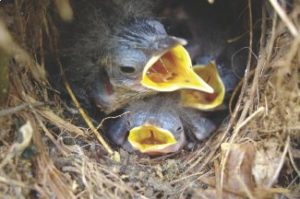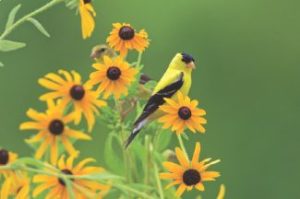Flying Colors is a sponsored column on the hobby of backyard bird feeding written by Michael Zuiker, owner of the Wild Birds Unlimited store at the Lee Harrison Shopping Center. Visit the store at 2437 N. Harrison Street or call 703-241-3988.
Well it is that time of year. Warm sunny days. Mild breezes. Finishing up one part of life and moving on to new adventures. New experiences. Learning how to live on your own and make your own life.
What? You think I was talking about your high school kids going to the ocean?
 It is fledging time when your yards and parks are full of baby birds. They are now out of the nests or will soon be. So yeah, maybe a lot of us are empty nesters, also.
It is fledging time when your yards and parks are full of baby birds. They are now out of the nests or will soon be. So yeah, maybe a lot of us are empty nesters, also.
They are fully grown and ready to move on. But for a day or two they will bounce around the ground. They have been in the nest and their wings are not fully strong enough to get them air born.
It is also a very dangerous time for these vulnerable birds to survive. And just like your empty nesters who may be headed to the beach — with 4 or 5 thousand dos or don’ts from the bill payers of the house — there are a few things you can do to help these young birds.
- Do not let your cats outdoors. Most cats prefer to stay indoors and watch reruns of the Royal Wedding anyway. It is healthier for the cats and safer for the birds.
- If you need to cut your lawn, take a quick walk around and look or listen for the little fledging’s. They will chirp and the parents are usually in the trees above calling out to them.
- Walk thorough your property to locate any nests. With a little detective work, you can spot them, especially if they are in medium height shrubs and bushes and low trees, i.e. Dogwoods. Look to see if there are any young hatchlings or if the nest is abandoned. But do not get fooled by the empty nest. Some birds such as House Wrens can have additional broods in early summer so you may have that opera singer taking up residence again.
- When you spot a bird on the ground, do not be alarmed. If it looks like a teenager with unclean clothes but is bouncing around and chirping, it most likely is fine. If it is your teenager, make him do the laundry.
- If the bird is without feathers and on the ground and moving, try to find the nest and put it back into it. The urban legend of birds abandoning their offspring because you touched it is not true. Birds have very little sense of smell. Adult birds are the best solution for feeding the young chicks until they are ready to fledge.
- Watch for accidental bumps into reflective windows. These can be painful but many times not fatal to the birds. If you notice or hear of constant window collisions, there are many types of decals to attach to the glass to help cut way down on this problem.
- If you find a bird on the ground that looks to be injured, you can call a local rehabilitator. The Wildlife Rescue League of Northern Virginia (703-840-0800) is a great resource to help with the recovery and rehabilitation of the injured bird. Be aware that most rehabilitators will not take in a non-native injured bird such as an English Sparrow or European Starling.
Adventurous, exhilarating, scary, fun-filled, exhausting. All of this and more are part of the growth, from birth to adulthood. All of nature goes through this.
 Get outside. Listen. Watch. Enjoy. Fledging birds are fun to watch, especially when the adults bring to your feeding stations and teach them how to eat. The softer foods, such as suet’s, Bark Butter Bits, and live mealworms are great sources of Protein and fat for these little rascals.
Get outside. Listen. Watch. Enjoy. Fledging birds are fun to watch, especially when the adults bring to your feeding stations and teach them how to eat. The softer foods, such as suet’s, Bark Butter Bits, and live mealworms are great sources of Protein and fat for these little rascals.
Remember also to keep your hummingbird feeder filled and fresh with nectar. Baby hummingbirds are also a treat to watch at the feeders. Hard to tell because of the size, but their inexperience will give them away.
Keep an eye out for those fledging’s. You never know when they may want to return to the roost!


